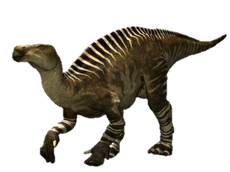
Iguanodon (i•guan•o•don) is a genus of ornithopod dinosaur that lived from about 139 to 90 million years ago, from the early to late Cretaceous period. Iguanodon was the second dinosaur ever discovered and it was one of the first dinosaurs to be named, preceded only by Megalosaurus. Iguanodon's name means "Iguana Tooth" due to its iguana-like teeth. It was the largest of its kind.
Iguanodon Skeleton
It lived in America and Europe, mainly in England in the UK, but had many relatives that lived all over the world, such as Ouranosaurus from North Africa, Altirhinus from Asia, and Rhabdodon from Southern Europe. It may have even lived alongside some of its relatives, such as Tenontosaurus. It was prey to a variety of carnivores, such as the giant predator Acrocanthosaurus, the smaller dromeosaurs known as Deinonychus, and possibly even the spinosaur Baryonyx in Europe.
Paleobiology
When the first Iguanodon skeleton was discovered it 1822, was believed to walk much like an iguana, on all four legs. Its thumb spike was believed to be a horn on its head (only one thumb spike was found). At one point it was also thought to have lived in trees, but this has been long since proven completly wrong.
One of the more notable characteristics of the Iguanodon species is its "thumbs". Instead of a thumb it had a large spike that paleontologists believed Iguanodons used for defensive purposes, but could have also been used for getting food. The "pinky" finger of an Iguanodon is believed to have acted as its thumb.
Palentologists belive that Iguanadon may have traveled in herds. In large herds of Iguanodons other dinosaurs, mainly the ankylosaur family, would join in the migrations to gain protection to the herd as a whole. It was mostly quadropedic, but could have stood up on its hind legs to reach tall plants or to run away quickly. They didn't have too flat of bills or like their hadrosaur descendents, but still had many teeth within its cheeked jaws and could chew tough food pretty easily. Iguanodon was perhaps the most successful dinosaur species, with it and its relatives being found on nearly every continent.
Wakling with Dinosaurs Iguanodon
In The Media
Iguanodon has been in several dinosaur-related merchandise. It was in the famous Walking with Dinosaurs series, and was shown to have travelled in herds with Polacanthus travelling alongside it, in England. The herd was later attacked by a pack of Utahraptor, in North America, and one of them was killed in the process.
Aladar from Disney's Dinosaur
An Iguanodon named Aladar who was raised by lemurs was the main character in Dinosaur, and was attacked by a Carnotaurus and a pack of Velociraptors while trying to get to a nesting ground valley. Other Iguanodons in the movie was a female who later became Aladar's mate named Neera, her brother named Kron the main antagonist, and the anti-hero named Bruton.
Old-Fashioned Iguanodon Statues
Iguanodon is one of the statues of dinosaurs in the Crystal Gardens in England. It also featured in an episode of Dinosaur Planet, where they were attacked by Pyroraptor, Tarascosaurus, and their dwarf forms on the Hateg island. It was not actually an Iguanodon but another species of its' kind - Rhabdodon.
Iguanodon appeared in Dinosaur Train and one individual in the series and his name is Iggy.
Iguanodon was one of the dinosaurs in Dinosaur Hunting (XBOX) to be rescued and captured in Stage 1, 2, and 6.
Iguanodon appeared in Jurassic Park Builder and Jurassic World Evolution.
In Papua New Guinea, people have said a few remaining living Iguanodon-like dinosaurs are still alive today, but there is no evidence to confirm its existence.